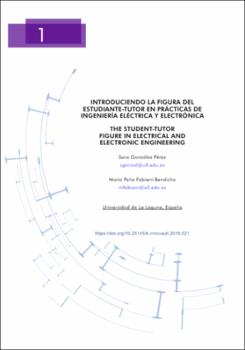Introduciendo la figura del estudiante-tutor en prácticas de ingeniería eléctrica y electrónica
Fecha
2019Resumen
En este trabajo se compara cómo la docencia práctica de materias tecnológicas puede
enriquecerse involucrando a los estudiantes en las propias labores docentes en dos
titulaciones diferentes: ingeniería eléctrica y electrónica. La experiencia ha consistido
en implementar labores de tutorización de prácticas de laboratorio, realizadas por
iguales (estudiantes-tutores). Luego se ha analizado si este cambio de paradigma
aumenta la motivación y el rendimiento, tanto de los estudiantes tutorizados como de
los estudiantes-tutores, al mismo tiempo que mejora las competencias del conjunto
global de estudiantes. Estas actividades de tutorización por iguales se han llevado a
cabo en los laboratorios de prácticas de cada una de las titulaciones involucradas en
esta experiencia. Además, se han recopilado evidencias y valoraciones cualitativas
por parte del alumnado respecto a la experiencia con estudiantes-tutores y con los
profesores cuando se utiliza el método tradicional (donde el profesor realiza todas las
labores de enseñanza) y se han comparado las experiencias obtenidas con ambas
metodologías. El resultado obtenido indica que la incorporación de esta innovación
metodológica en ambas ingenierías, mejora tanto la motivación como el rendimiento
de alumnos y alumnas, independientemente del tipo de titulación evaluada. This paper compares how the practical teaching of technological subjects can be
enriched by involving students in their own teaching tasks in two different degrees:
electrical and electronic engineering. The experience consists in implementing tasks
of tutoring laboratory practices, carried out by peers (students-tutors). Then, it was
analyzed if this paradigm change increases the motivation and performance of both
the tutor students and the student-tutors, while improving the skills of the global student
body. These peer tutoring activities have been carried out in the practical laboratories
of each of the degrees involved in this experience. In addition, qualitative evidences
and assessments have been compiled by the students regarding the experience with
students-tutors and with the teachers when the traditional method is used (where the
teacher performs all the teaching tasks) and the experiences obtained have been compared
with both methodologies. The obtained result indicates that the incorporation
of this methodological innovation in both engineering, improves both the motivation
and the performance of students, regardless of the type of degree evaluated.






